Yess Restaurant (Los Angeles, CA)
Yess Restaurant
2001 E 7th St, Los Angeles, CA 90021
www.instagram.com/yess.restaurant/ / www.yessaquatic.com
Wed 12/20/2023, 07:30p-11:15p

Of all the LA-area restaurants debuts of 2023, Yess was certainly one of the ones that I was the most curious about, so I made it a point to visit the Downtown spot before the end of the year. The place comes to us from Chef Junya Yamasaki (most known for his time running the cult-y Koya in London), in partnership with Sumiko Himura, Akiko Kaetsu, and Kazuko Kaetsu, who together form a company called Hi Hi Heel Productions. The cuisine served at Yess is described by the team as "progressive Japanese," but also focuses on wood- and charcoal-fired cookery, as well as the use of ingredients local to Southern California.
About the Chef: Yamasaki Junya hails from Hyogo, in the Kansai region of Japan. He attended the University of Tsukuba, then worked in magazines and film (that's how he met future business partner Kino Kaetsu, a producer) before relocating to the United Kingdom. There, he studied photography at Goldsmiths, University of London, during which time he managed a café, and later moved to France, enrolling in a fine arts DNSEP program at ENSAPC (École Nationale Supérieure d'Arts de Paris-Cergy). In Paris, he began working at Masafumi Nomoto's udon restaurant Kunitoraya, though not as a cook.
It was around this period when Yamasaki would meet John Devitt, a former options trader who'd left the finance field for a career in hospitality. Devitt had trained at London Italian mainstay Zafferano under Giorgio Locatelli, with plans to open his own restaurant, but after tasting Sanuki udon for the first time at Kunitoraya, decided that he wanted to focus on those noodles. To open the udon-ya, Devitt recruited Yamasaki as well as Shuko Oda, who'd had some kitchen experience Japan but spent most of her career in fashion. Oda and Yamasaki had initially met while working at Dover Street Market, a clothier in London, and after the concept behind Koya was decided on, she went to train at Kunitoraya for three months, while Yamasaki traveled to Shikoku for culinary research.
The three were able debut Koya in Soho in April 2010 (in the former Alistair Little space at 49 Frith St), and the place soon became one of the most happening eateries in London. Besides the udon, Yamasaki began making a name for himself for his daily-changing specials, featuring British ingredients prepared in a Japanese style, and even went to stage at Magnus Nilsson's Fäviken Magasinet and Dan Hunter's Royal Mail down in Australia. In September 2013, the partners launched Koya Bar next door with Oda running things, while Yamasaki stayed in charge of the original restaurant. However, despite all the success, Yamasaki stepped away from the business in 2015, and Koya ended up serving its last bowl of udon at the end of May that year.
The Chef then returned to Japan in the autumn, did some traveling, and immersed himself in Zen Buddhism and its associated temple cuisine, even staying at a monastery in the mountains for three months. Yamasaki arrived in LA around the end of 2018, and was appalled by the widespread use of imported seafood in the city. He thus set out to utilize local product in his cooking, meeting with local fishermen and even going as far as to free-dive for seafood himself. In December 2020, the Chef launched a food truck called Yess Aquatic, which he parked near his future restaurant location, and joining him were Giles Clark (sous) and Jacob Himmel (junior sous).
Clark, for his part, comes to us from England, and studied philosophy and theology at Trinity College Dublin following a tenure at Eton College. During his time at TCD, he worked at the posh Restaurant Patrick Guilbaud in Dublin, and later staged at Chez Panisse, River Cottage, Alinea, and Noma. By spring 2012, he was cooking at The Ten Bells with The Young Turks, then made his way over to St John Bread and Wine. He then joined Yamasaki and company at Koya, where he served as sous chef until shortly before the spot shuttered. Afterward, he went to Japan to train at legendary kaiseki restaurant Kikunoi Honten in Kyoto, then worked for a local fishmonger, and I believe that he also studied tofu-making around this time.
Himmel, meanwhile, is an American, and grew up in the Chicago area. He attended the International Culinary Center in New York, during which time he cooked at Italian eatery All'onda. After completing his studies in December 2015, he became an opening line cook at Momofuku Nishi, and was promoted to sous a year later. At the start of 2018, he decamped in order to stage at Noma, and was actually part of the opening team of Noma 2.0. Following, Himmel returned to the US and got a job at Jaguar Sun in Miami, then, at the start of 2019, went to Japan to apprentice at Terada Honke sake brewery. In June 2019, he started working for Bravo Restaurants back in Chicago, where he focused on revamping the menu at Eduardo's Enoteca, then joined Yess in 2020.
Yess' mobile operation lasted until October 4th, 2021, but Yamasaki soon started up a series of Yess Aquatic Supper Club dinners that December, and continued to pop-up through late 2022. The brick-and-mortar restaurant, meanwhile, debuted on May 3rd this year with a relatively easy-going à la carte menu, but switched to a tasting menu format in September. Soon after, Yess began racking up the accolades, landing on the New York Times' list of the 50 most exciting restaurants in the US. The NY Times quickly followed that up by naming Yess one of the "25 Best Restaurants in Los Angeles Right Now," while Esquire deemed the place one of "The Best New Restaurants in America."

Yess resides in a 1924 building in the Arts District that once housed a Bank of America branch before being left vacant for decades. I find it to be a peculiar space, especially with those huge glass block windows and that super lengthy cypress wood kitchen counter. An interesting point is that the chairs are reportedly made from leftovers of the wood used to reconstruct the Ise Jingū shrine back in 2013.

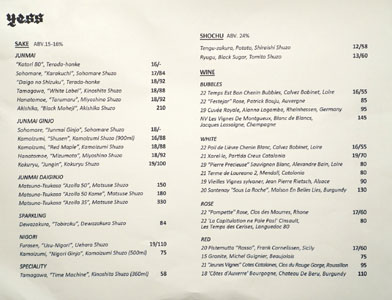

The menu here is a six-course prix fixe at $110 a head, with your choice of main dish as well as optional supplements, while a more casual à la carte menu is served on Sundays. Beverage-wise, you get a tight selection of sakes and natural-leaning wines, along with a couple shochus, a couple cocktails, and a single beer, all curated by Yukiyasu Kaneko (P. Franco, Noma). Corkage is $50 a bottle. Click for larger versions.
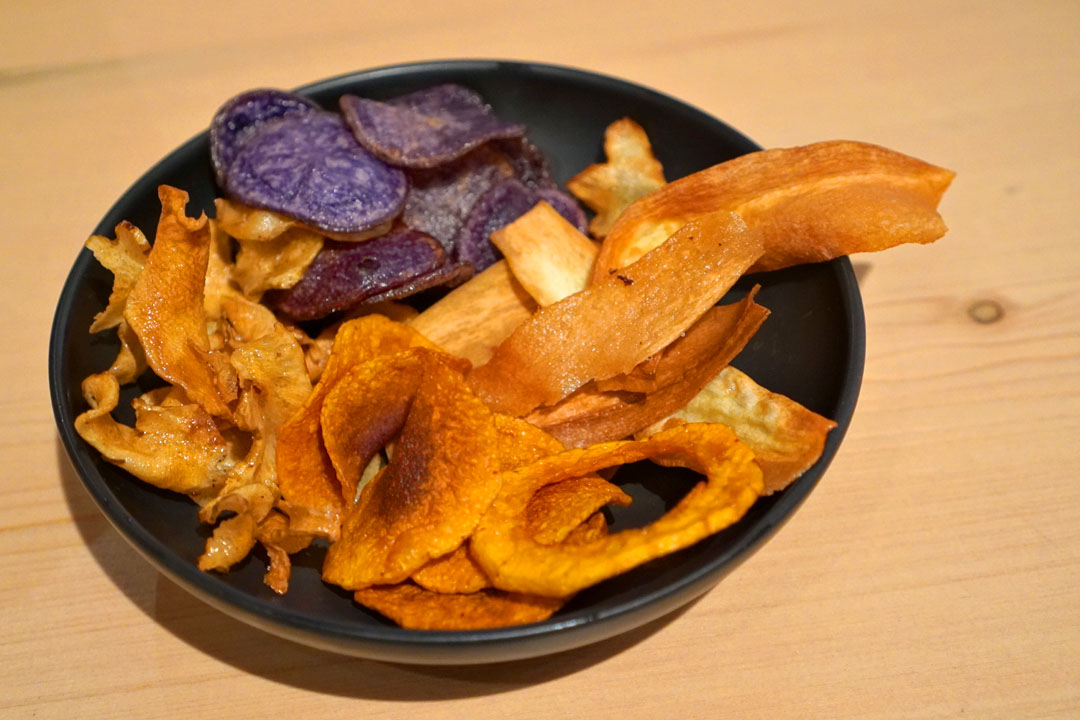
My meal commenced with a serving of fried winter vegetables (honeynut squash, parsnips, sunchokes, beets), which served as an exploration of the disparate types of both crunchiness and salty-sweet ratios.
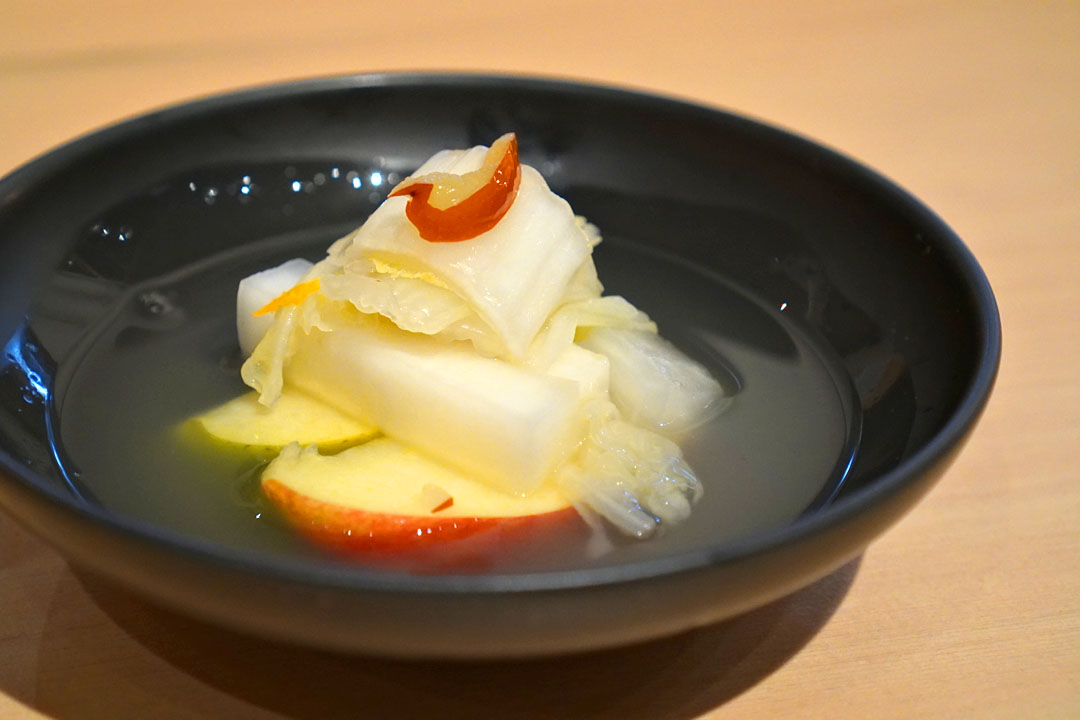
1: Water Kimchi | with Market Vegetables and Fruits
What appeared to be a riff on dongchimi combined the usual baechu (or hakusai, perhaps more appropriately) with fermented daikon, apple, serrano pepper, and yuzu zest. I appreciated the bitter, slightly peppery liquid, and the array of textures was also quite fetching, while the apple added an unexpected sweetness to the fray. Overall, a refreshing and palate-perking course.
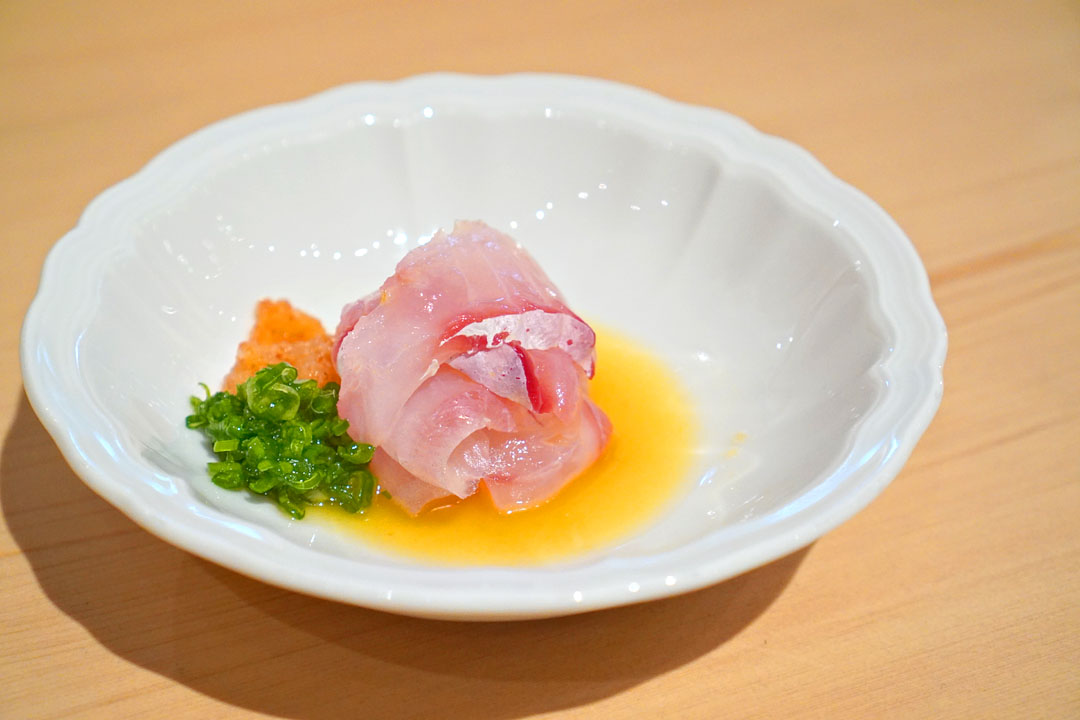
2: California Sweet Bream Sashimi | with Passion Fruit and Makrut Lime Ponzu
Amadai showed off a wonderful chew, its sweetness coming together seamlessly with that extra-citrusy ponzu, a touch of heat, and the zippiness of green onion.
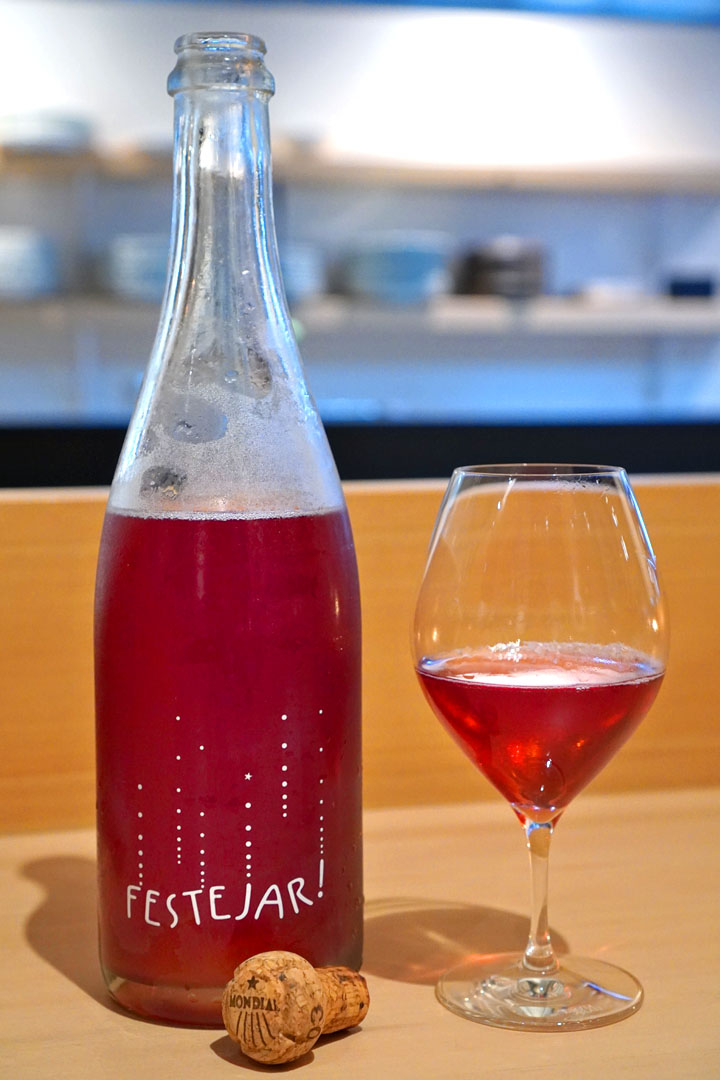
I opted for something easy-drinking in the form of the Gamay d'Auvergne-based 22 "Festejar" Rose, Patrick Bouju, Auvergne [$85]. The pét-nat smelled of tart, juicy red fruits, but with an earthy backing, while the palate demonstrated similar notes, and actually went in a somewhat beer-like direction, reminding me of a fruited saison. An utterly quaffable wine that stood up admirably to the food tonight.
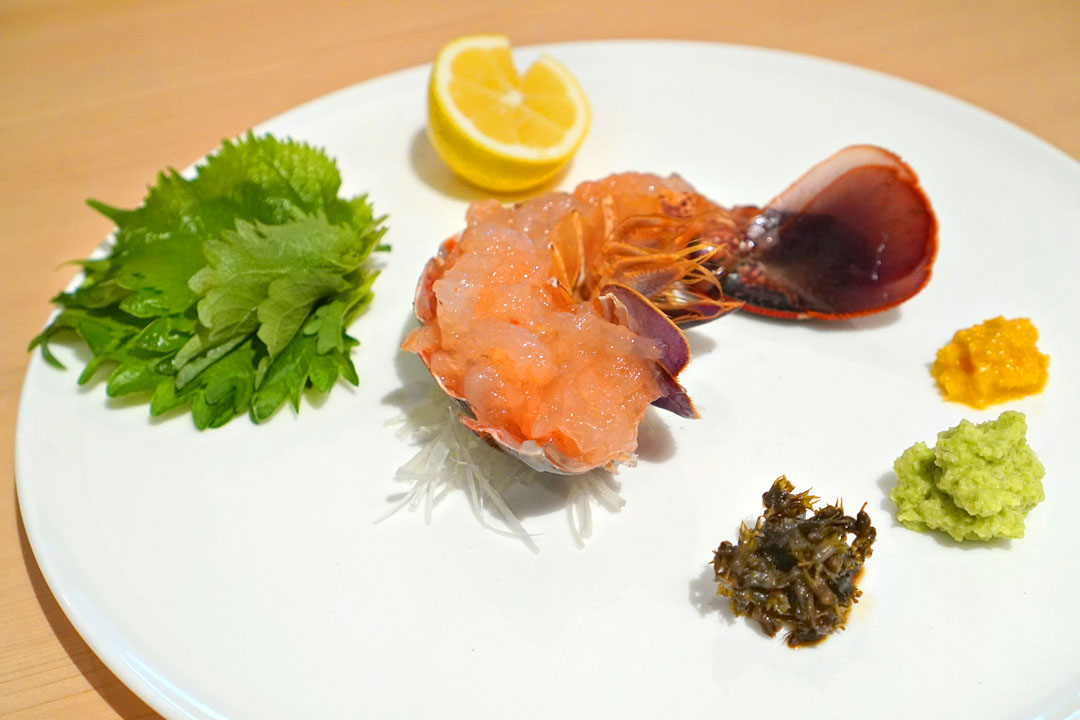
Supplement: Lobster Tartar [$60.00] | Local Spiny Lobster Tartar with fresh Wasabi and Soy pickled Shiso Buds
Ise ebi arrived sticky and supple, with a delicately sweet brine that combined well with the freshness of those shiso leaves, and also opened up with a squirt of citrus. However, the fun part was pairing the tartare with its trio of condiments. The wasabi had that classic heat, which of course made sense, though far more interesting were the soy-pickled shiso buds, which were simultaneously savory yet floral. My favorite accoutrement, however, was the habanero-yuzu, which possessed this wonderfully fruity heat. I also tried all three together, and the combo actually worked somehow, and didn't manage to overwhelm the lobster.
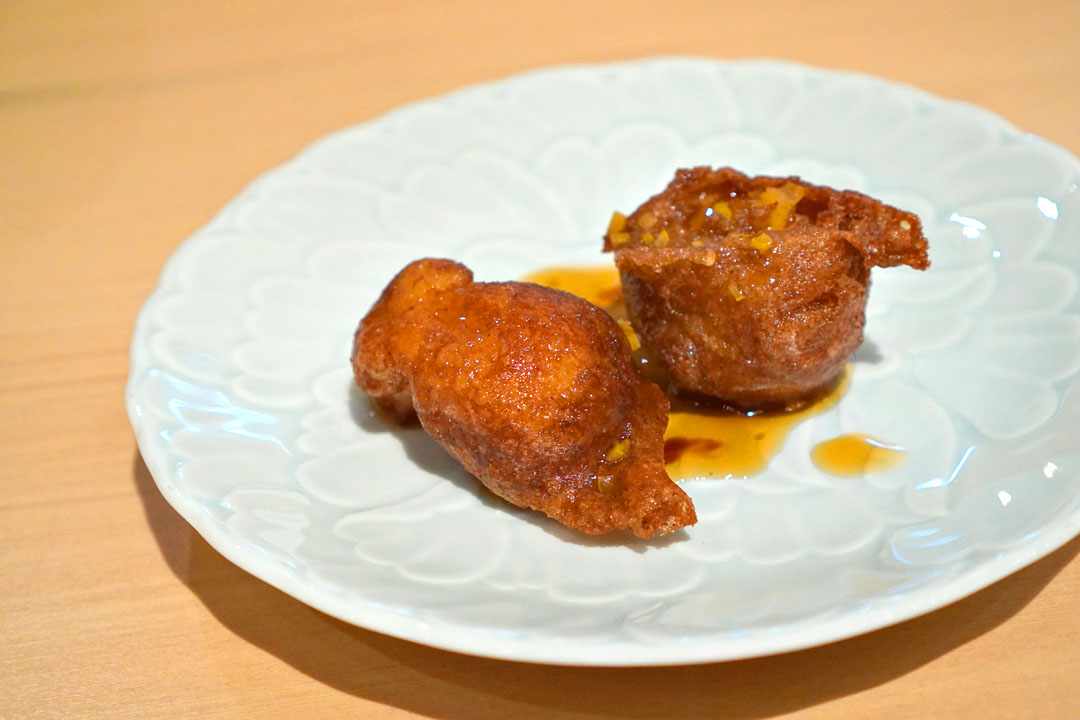
3: Ling Cod Fritter | with Yuzu "An" Sauce
Lingcod fritters paired flaky, juicy, mild-tasting insides with crisp-fried, slightly sweet exteriors that actually recalled youtiao. Helping to tie the dish together, meanwhile, was that thick, piquant sauce, which I'm assuming was derived from ankake.
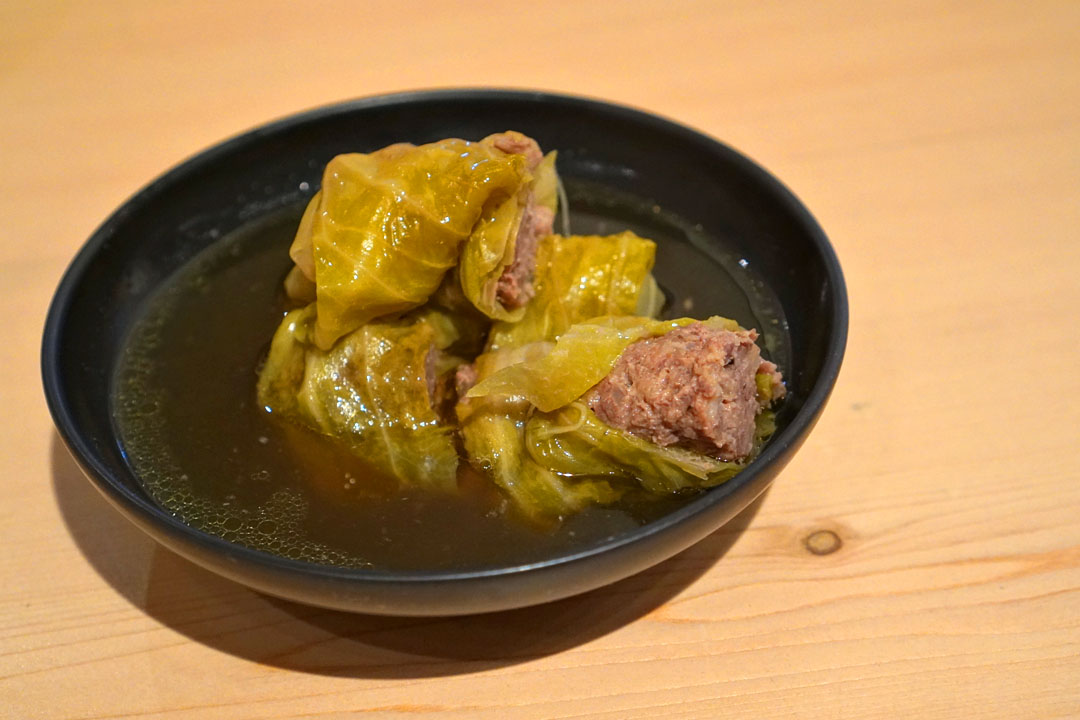
Supplement: Lamb and Sour Cabbage Rolls [$16.00] | Lightly pickled Cabbage Rolls stuffed with minced Shoulder of Windrose Farm Lamb and braised in Dashi
Lamb took on the familiar, classic, savory flavors of dashi, and effectively played off of the cabbage's tangy, vegetal nature. I also detected a peppery edge in the dish, and somehow, I tasted raisin on the finish.
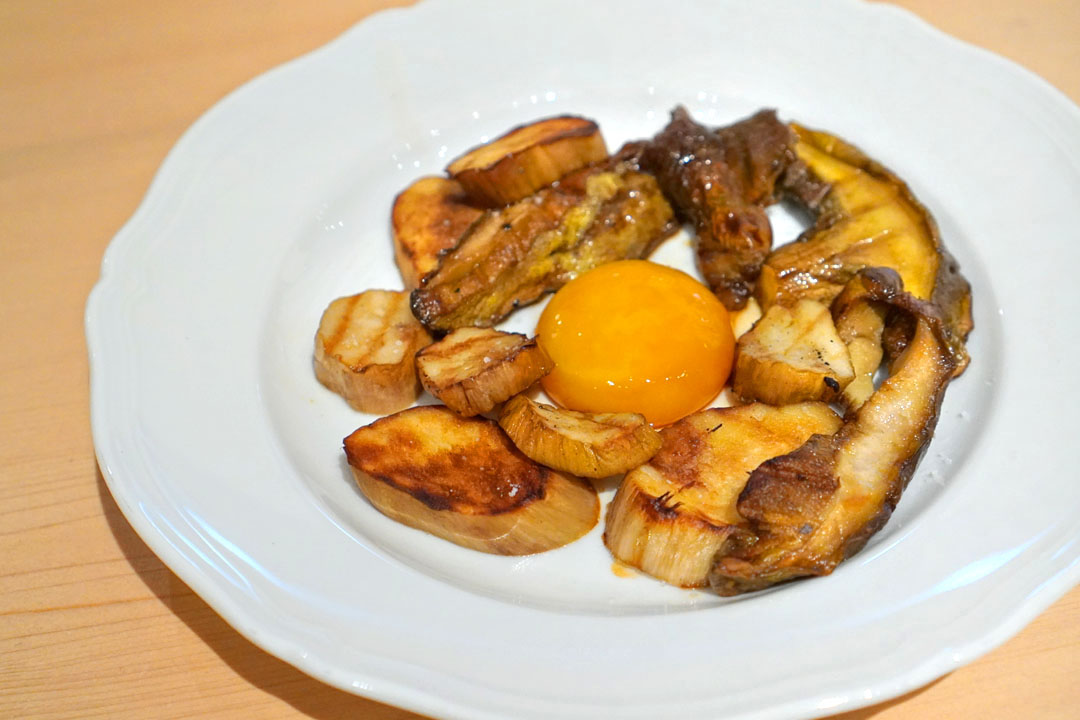
Supplement: Porcini & Soy Egg Yolk [$28.00] | Grilled California Porcini and Soy cured Egg Yolk
Cuts of porcini exhibited a welcomed contrast in textures, with some bits having a meaty, snappy consistency, while others were soft and nearly eggplant-like. Taste-wise, their roasty, woodsy qualities played well with the luscious, umami-laden character of that yolk, making for an appropriately autumnal dish.
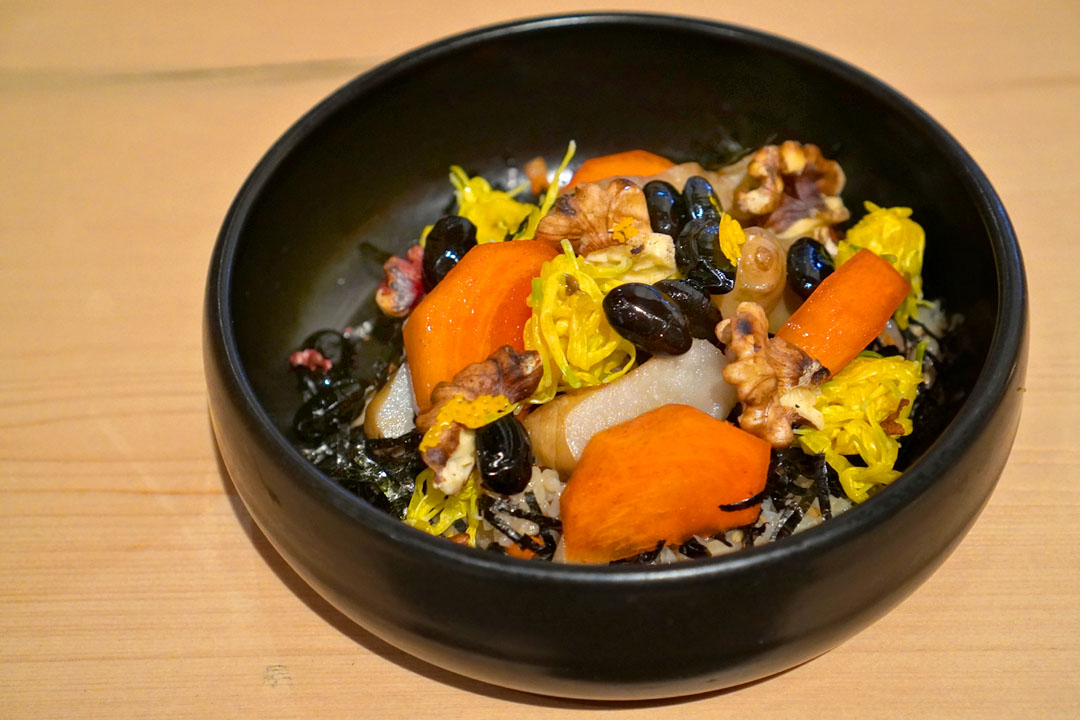
4: Monk's "Chirashi-Sushi"
Next up was the latest version of a seasonally-changing course, one comprising sweet beans, seaweed, sunchoke, persimmon, chrysanthemum flowers, and walnuts roasted in their shells. The dish represented a hodgepodge of tastes and textures, but one that came together in a clever manner. The umami notes from the seaweed were key, and really set the stage for a bevy of sweet, nutty, and pickle-y flavors. I was a fan of the just-sticky-enough texture on the rice, too.
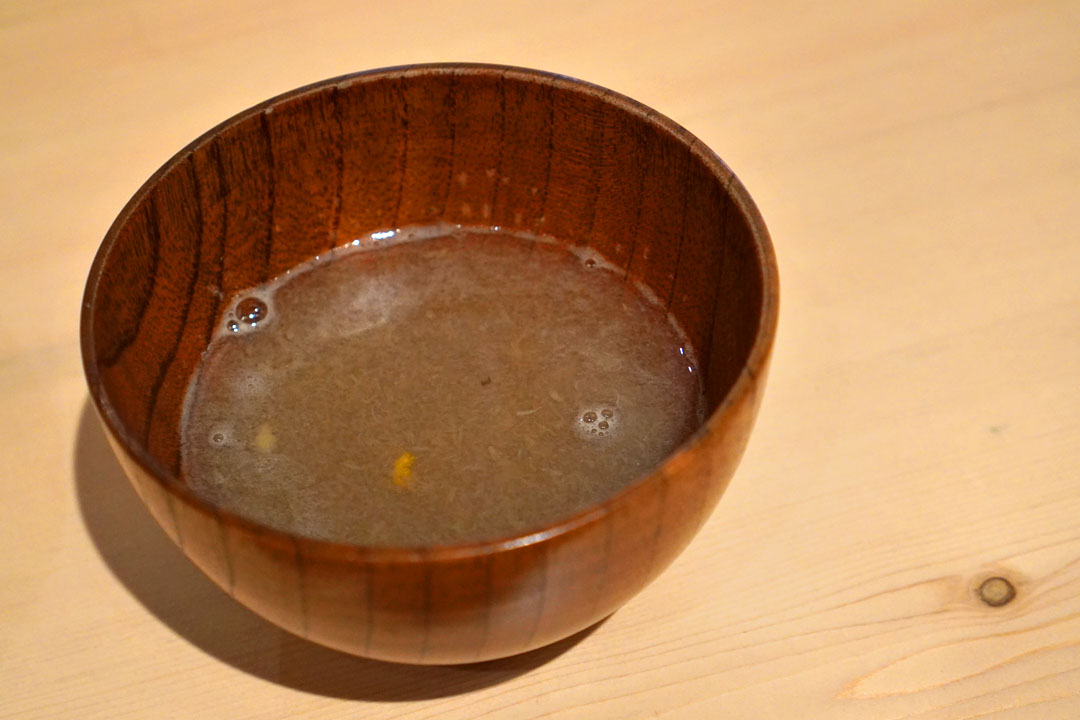
5: White Turnip "Surinagashi" Soup
Along with the rice above came a hot, heartwarming soup loaded with delectably bitter, ginger-y notes. I wouldn't have minded a bigger bowl of the stuff.
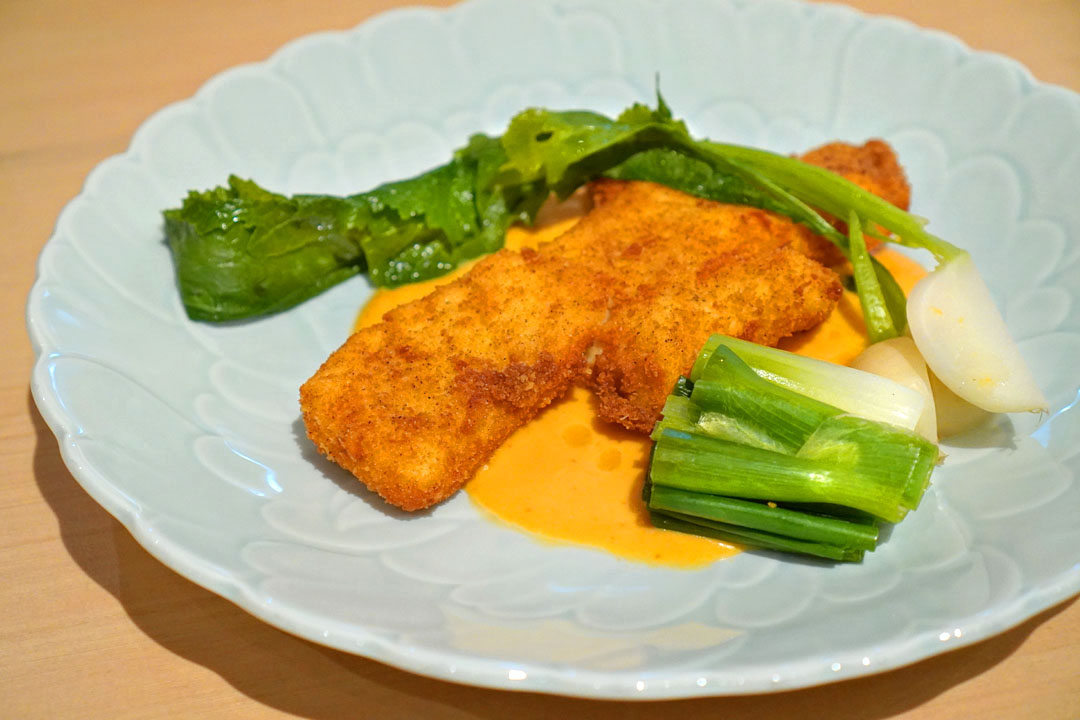
6: Halibut Schnitzel and Warm Rouille Sauce | Shinkei-jime Halibut Cutlet with steamed Turnip and Scallion, served with grilled Sweet Potato and Habanero Rouille
Given my penchant for schnitzel of all sorts, this was an obvious choice for my main course. The crux here was the interplay between the fruity, lingering heat of the habanero and the zesty scallions, which was just fantastic. It was a pretty intense back-and-forth, yet managed not to overwhelm the comparatively delicate taste of the fish, and I liked how the turnips lightened things up.
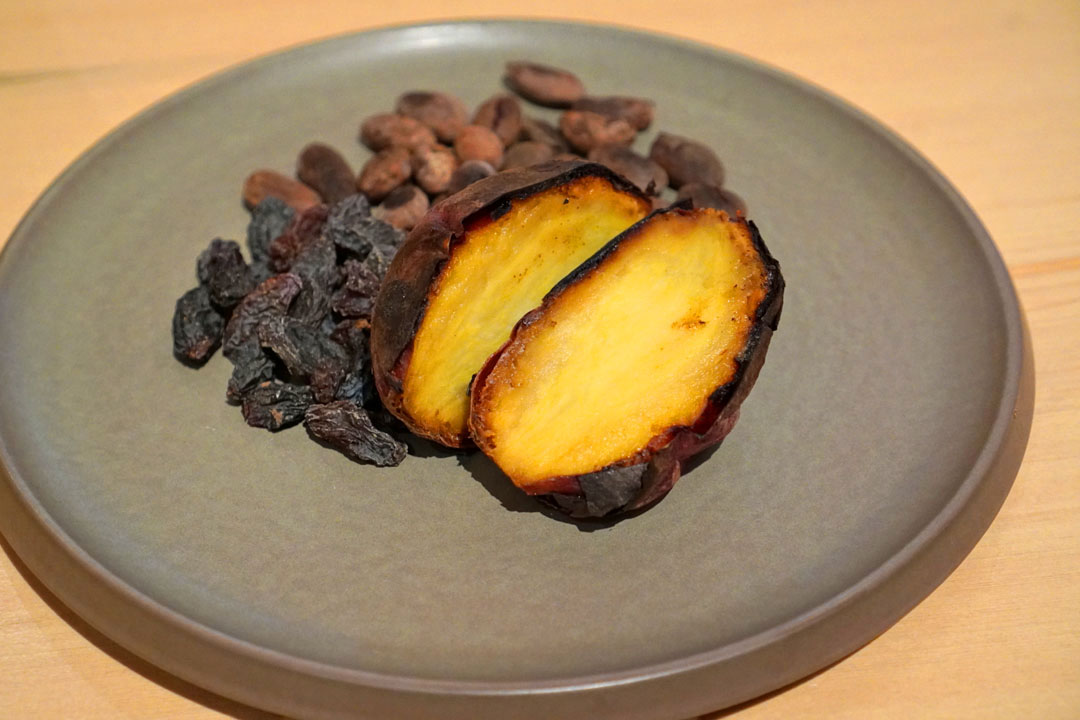
Supplement: Cacao, Raisins and Sweet Potato [$20.00] | Comal roasted Japanese Sweet Potato, Cacao Beans and Raisins
Dessert was pretty unconventional, and might just be the most contemplative I've had all year. For me, the way to approach this was to enjoy the sweet smokiness of the yaki-imo, then juxtapose that with the more overt sweetness of the raisins, and the far more aggressively smoky, roasty, nutty aspects of the cacao.
The food at Yess is fundamentally Japanese at its core if we're talking technique and ethos, but the cuisine has been re-interpreted through the lens of seasonal Californian ingredients. That's not the whole story here, though. Yamasaki's cooking has a direct, minimalistic, almost monastic feel to it, and comes across as quite "cheffy," so to speak. It's an approach that appealed to me, but at the same time, I could very easily imagine it as being off-putting to many others. This seems like a polarizing sort of place, and in fact, might be the most polarizing restaurant debut since Meteora. And if that wasn't enough, the leisurely service and general vibe made for a rather unique dining experience. I'm not sure how to describe it, but the words that come to mind are cinematic, beguiling, and even a bit surreal at times. Yess isn't for everybody.
As for the team's next steps, they're still planning on launching the more casual Yess Cafe in the same building once things stabilize. Further objectives consist of a members-only space called Good Brown, as well as another, unnamed project that will include a bakery and coffee roaster. Thus, Yamasaki and his crew have some ambitious plans, so I hope that Angelenos are receptive to them.
2001 E 7th St, Los Angeles, CA 90021
www.instagram.com/yess.restaurant/ / www.yessaquatic.com
Wed 12/20/2023, 07:30p-11:15p

Of all the LA-area restaurants debuts of 2023, Yess was certainly one of the ones that I was the most curious about, so I made it a point to visit the Downtown spot before the end of the year. The place comes to us from Chef Junya Yamasaki (most known for his time running the cult-y Koya in London), in partnership with Sumiko Himura, Akiko Kaetsu, and Kazuko Kaetsu, who together form a company called Hi Hi Heel Productions. The cuisine served at Yess is described by the team as "progressive Japanese," but also focuses on wood- and charcoal-fired cookery, as well as the use of ingredients local to Southern California.
About the Chef: Yamasaki Junya hails from Hyogo, in the Kansai region of Japan. He attended the University of Tsukuba, then worked in magazines and film (that's how he met future business partner Kino Kaetsu, a producer) before relocating to the United Kingdom. There, he studied photography at Goldsmiths, University of London, during which time he managed a café, and later moved to France, enrolling in a fine arts DNSEP program at ENSAPC (École Nationale Supérieure d'Arts de Paris-Cergy). In Paris, he began working at Masafumi Nomoto's udon restaurant Kunitoraya, though not as a cook.
It was around this period when Yamasaki would meet John Devitt, a former options trader who'd left the finance field for a career in hospitality. Devitt had trained at London Italian mainstay Zafferano under Giorgio Locatelli, with plans to open his own restaurant, but after tasting Sanuki udon for the first time at Kunitoraya, decided that he wanted to focus on those noodles. To open the udon-ya, Devitt recruited Yamasaki as well as Shuko Oda, who'd had some kitchen experience Japan but spent most of her career in fashion. Oda and Yamasaki had initially met while working at Dover Street Market, a clothier in London, and after the concept behind Koya was decided on, she went to train at Kunitoraya for three months, while Yamasaki traveled to Shikoku for culinary research.
The three were able debut Koya in Soho in April 2010 (in the former Alistair Little space at 49 Frith St), and the place soon became one of the most happening eateries in London. Besides the udon, Yamasaki began making a name for himself for his daily-changing specials, featuring British ingredients prepared in a Japanese style, and even went to stage at Magnus Nilsson's Fäviken Magasinet and Dan Hunter's Royal Mail down in Australia. In September 2013, the partners launched Koya Bar next door with Oda running things, while Yamasaki stayed in charge of the original restaurant. However, despite all the success, Yamasaki stepped away from the business in 2015, and Koya ended up serving its last bowl of udon at the end of May that year.
The Chef then returned to Japan in the autumn, did some traveling, and immersed himself in Zen Buddhism and its associated temple cuisine, even staying at a monastery in the mountains for three months. Yamasaki arrived in LA around the end of 2018, and was appalled by the widespread use of imported seafood in the city. He thus set out to utilize local product in his cooking, meeting with local fishermen and even going as far as to free-dive for seafood himself. In December 2020, the Chef launched a food truck called Yess Aquatic, which he parked near his future restaurant location, and joining him were Giles Clark (sous) and Jacob Himmel (junior sous).
Clark, for his part, comes to us from England, and studied philosophy and theology at Trinity College Dublin following a tenure at Eton College. During his time at TCD, he worked at the posh Restaurant Patrick Guilbaud in Dublin, and later staged at Chez Panisse, River Cottage, Alinea, and Noma. By spring 2012, he was cooking at The Ten Bells with The Young Turks, then made his way over to St John Bread and Wine. He then joined Yamasaki and company at Koya, where he served as sous chef until shortly before the spot shuttered. Afterward, he went to Japan to train at legendary kaiseki restaurant Kikunoi Honten in Kyoto, then worked for a local fishmonger, and I believe that he also studied tofu-making around this time.
Himmel, meanwhile, is an American, and grew up in the Chicago area. He attended the International Culinary Center in New York, during which time he cooked at Italian eatery All'onda. After completing his studies in December 2015, he became an opening line cook at Momofuku Nishi, and was promoted to sous a year later. At the start of 2018, he decamped in order to stage at Noma, and was actually part of the opening team of Noma 2.0. Following, Himmel returned to the US and got a job at Jaguar Sun in Miami, then, at the start of 2019, went to Japan to apprentice at Terada Honke sake brewery. In June 2019, he started working for Bravo Restaurants back in Chicago, where he focused on revamping the menu at Eduardo's Enoteca, then joined Yess in 2020.
Yess' mobile operation lasted until October 4th, 2021, but Yamasaki soon started up a series of Yess Aquatic Supper Club dinners that December, and continued to pop-up through late 2022. The brick-and-mortar restaurant, meanwhile, debuted on May 3rd this year with a relatively easy-going à la carte menu, but switched to a tasting menu format in September. Soon after, Yess began racking up the accolades, landing on the New York Times' list of the 50 most exciting restaurants in the US. The NY Times quickly followed that up by naming Yess one of the "25 Best Restaurants in Los Angeles Right Now," while Esquire deemed the place one of "The Best New Restaurants in America."

Yess resides in a 1924 building in the Arts District that once housed a Bank of America branch before being left vacant for decades. I find it to be a peculiar space, especially with those huge glass block windows and that super lengthy cypress wood kitchen counter. An interesting point is that the chairs are reportedly made from leftovers of the wood used to reconstruct the Ise Jingū shrine back in 2013.



The menu here is a six-course prix fixe at $110 a head, with your choice of main dish as well as optional supplements, while a more casual à la carte menu is served on Sundays. Beverage-wise, you get a tight selection of sakes and natural-leaning wines, along with a couple shochus, a couple cocktails, and a single beer, all curated by Yukiyasu Kaneko (P. Franco, Noma). Corkage is $50 a bottle. Click for larger versions.

My meal commenced with a serving of fried winter vegetables (honeynut squash, parsnips, sunchokes, beets), which served as an exploration of the disparate types of both crunchiness and salty-sweet ratios.

1: Water Kimchi | with Market Vegetables and Fruits
What appeared to be a riff on dongchimi combined the usual baechu (or hakusai, perhaps more appropriately) with fermented daikon, apple, serrano pepper, and yuzu zest. I appreciated the bitter, slightly peppery liquid, and the array of textures was also quite fetching, while the apple added an unexpected sweetness to the fray. Overall, a refreshing and palate-perking course.

2: California Sweet Bream Sashimi | with Passion Fruit and Makrut Lime Ponzu
Amadai showed off a wonderful chew, its sweetness coming together seamlessly with that extra-citrusy ponzu, a touch of heat, and the zippiness of green onion.

I opted for something easy-drinking in the form of the Gamay d'Auvergne-based 22 "Festejar" Rose, Patrick Bouju, Auvergne [$85]. The pét-nat smelled of tart, juicy red fruits, but with an earthy backing, while the palate demonstrated similar notes, and actually went in a somewhat beer-like direction, reminding me of a fruited saison. An utterly quaffable wine that stood up admirably to the food tonight.

Supplement: Lobster Tartar [$60.00] | Local Spiny Lobster Tartar with fresh Wasabi and Soy pickled Shiso Buds
Ise ebi arrived sticky and supple, with a delicately sweet brine that combined well with the freshness of those shiso leaves, and also opened up with a squirt of citrus. However, the fun part was pairing the tartare with its trio of condiments. The wasabi had that classic heat, which of course made sense, though far more interesting were the soy-pickled shiso buds, which were simultaneously savory yet floral. My favorite accoutrement, however, was the habanero-yuzu, which possessed this wonderfully fruity heat. I also tried all three together, and the combo actually worked somehow, and didn't manage to overwhelm the lobster.

3: Ling Cod Fritter | with Yuzu "An" Sauce
Lingcod fritters paired flaky, juicy, mild-tasting insides with crisp-fried, slightly sweet exteriors that actually recalled youtiao. Helping to tie the dish together, meanwhile, was that thick, piquant sauce, which I'm assuming was derived from ankake.

Supplement: Lamb and Sour Cabbage Rolls [$16.00] | Lightly pickled Cabbage Rolls stuffed with minced Shoulder of Windrose Farm Lamb and braised in Dashi
Lamb took on the familiar, classic, savory flavors of dashi, and effectively played off of the cabbage's tangy, vegetal nature. I also detected a peppery edge in the dish, and somehow, I tasted raisin on the finish.

Supplement: Porcini & Soy Egg Yolk [$28.00] | Grilled California Porcini and Soy cured Egg Yolk
Cuts of porcini exhibited a welcomed contrast in textures, with some bits having a meaty, snappy consistency, while others were soft and nearly eggplant-like. Taste-wise, their roasty, woodsy qualities played well with the luscious, umami-laden character of that yolk, making for an appropriately autumnal dish.

4: Monk's "Chirashi-Sushi"
Next up was the latest version of a seasonally-changing course, one comprising sweet beans, seaweed, sunchoke, persimmon, chrysanthemum flowers, and walnuts roasted in their shells. The dish represented a hodgepodge of tastes and textures, but one that came together in a clever manner. The umami notes from the seaweed were key, and really set the stage for a bevy of sweet, nutty, and pickle-y flavors. I was a fan of the just-sticky-enough texture on the rice, too.

5: White Turnip "Surinagashi" Soup
Along with the rice above came a hot, heartwarming soup loaded with delectably bitter, ginger-y notes. I wouldn't have minded a bigger bowl of the stuff.

6: Halibut Schnitzel and Warm Rouille Sauce | Shinkei-jime Halibut Cutlet with steamed Turnip and Scallion, served with grilled Sweet Potato and Habanero Rouille
Given my penchant for schnitzel of all sorts, this was an obvious choice for my main course. The crux here was the interplay between the fruity, lingering heat of the habanero and the zesty scallions, which was just fantastic. It was a pretty intense back-and-forth, yet managed not to overwhelm the comparatively delicate taste of the fish, and I liked how the turnips lightened things up.

Supplement: Cacao, Raisins and Sweet Potato [$20.00] | Comal roasted Japanese Sweet Potato, Cacao Beans and Raisins
Dessert was pretty unconventional, and might just be the most contemplative I've had all year. For me, the way to approach this was to enjoy the sweet smokiness of the yaki-imo, then juxtapose that with the more overt sweetness of the raisins, and the far more aggressively smoky, roasty, nutty aspects of the cacao.
The food at Yess is fundamentally Japanese at its core if we're talking technique and ethos, but the cuisine has been re-interpreted through the lens of seasonal Californian ingredients. That's not the whole story here, though. Yamasaki's cooking has a direct, minimalistic, almost monastic feel to it, and comes across as quite "cheffy," so to speak. It's an approach that appealed to me, but at the same time, I could very easily imagine it as being off-putting to many others. This seems like a polarizing sort of place, and in fact, might be the most polarizing restaurant debut since Meteora. And if that wasn't enough, the leisurely service and general vibe made for a rather unique dining experience. I'm not sure how to describe it, but the words that come to mind are cinematic, beguiling, and even a bit surreal at times. Yess isn't for everybody.
As for the team's next steps, they're still planning on launching the more casual Yess Cafe in the same building once things stabilize. Further objectives consist of a members-only space called Good Brown, as well as another, unnamed project that will include a bakery and coffee roaster. Thus, Yamasaki and his crew have some ambitious plans, so I hope that Angelenos are receptive to them.
0 Comments:
Post a Comment
Subscribe to Post Comments [Atom]
<< Home